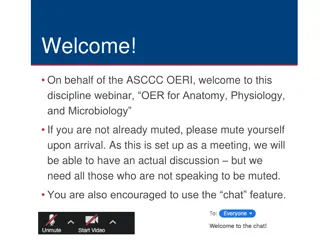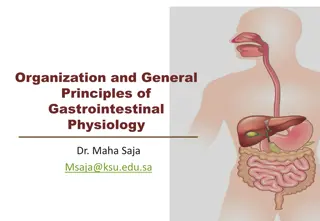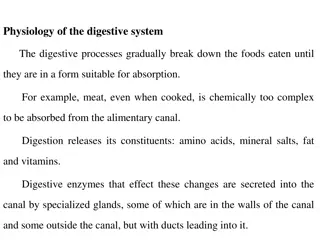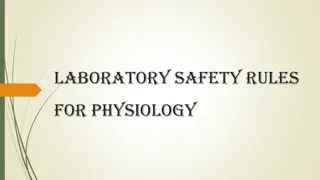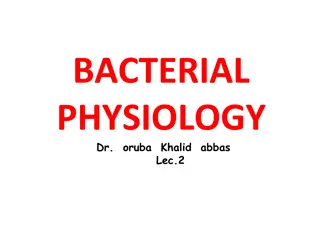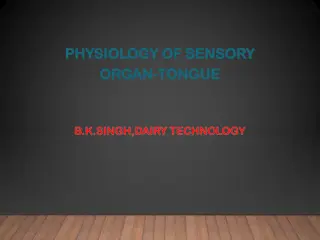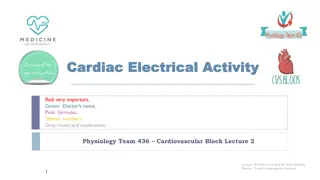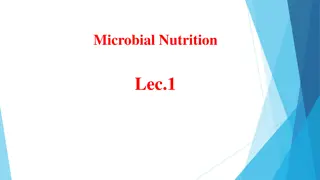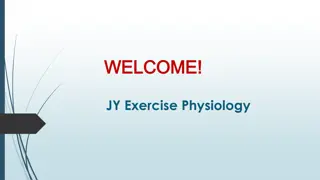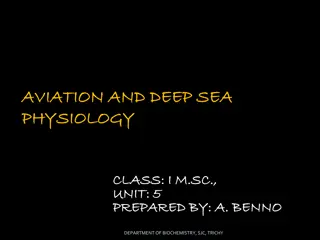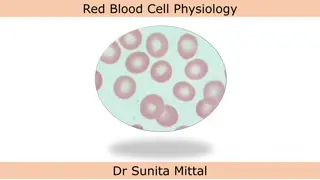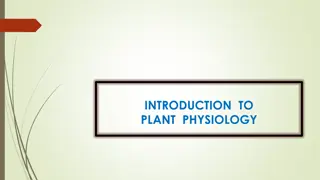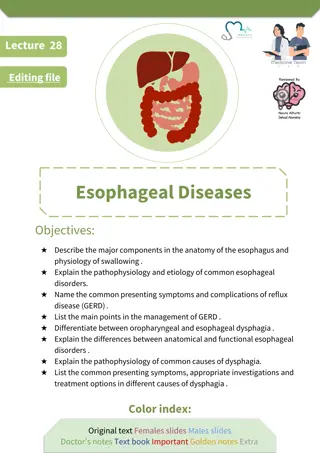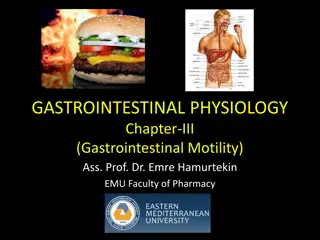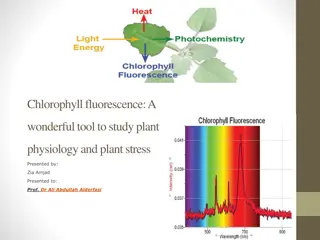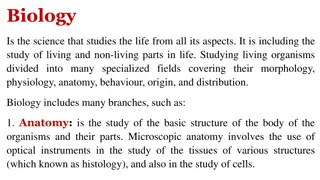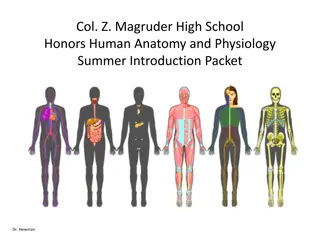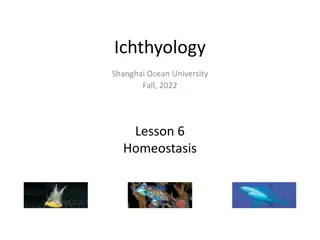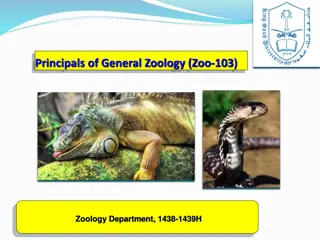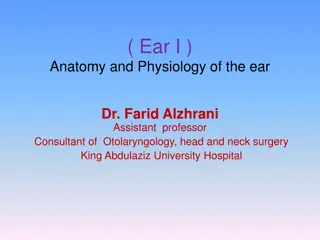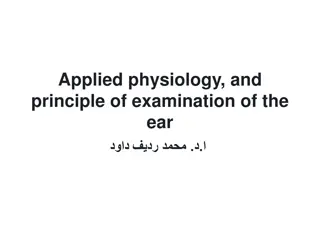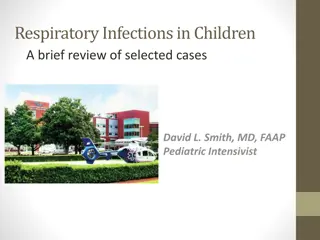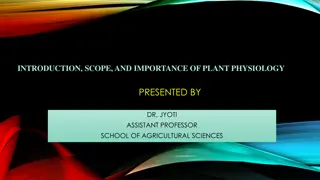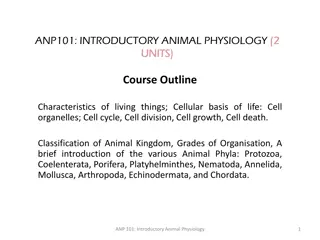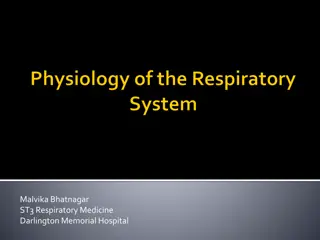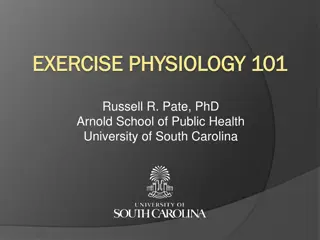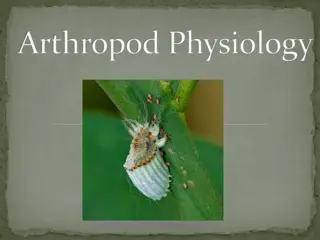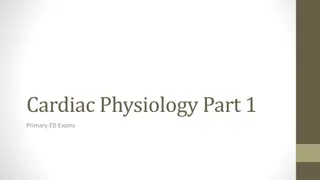Physiology of Pain
The physiology of pain, including its definition, types, causes, nociceptive pathway, transmission, and more. Gain a comprehensive understanding of pain terminology and different phases of nociceptive pain.
13 views • 40 slides
Anatomy and Physiology of the Larynx: Overview and Cartilages
Exploring the anatomy and physiology of the larynx, this content discusses the location, movements, and cartilages of the larynx. Details on the unpaired (thyroid, cricoid, epiglottis) and paired (arytenoid, corniculate, cunieform) cartilages are provided, along with their functions and characterist
9 views • 17 slides
ASCCC OERI Webinar on OER for Anatomy, Physiology, and Microbiology
Welcome to the ASCCC OERI webinar focused on Open Educational Resources (OER) for Anatomy, Physiology, and Microbiology. This event discusses the adoption of OER in California Community Colleges, challenges faced in Anatomy and Physiology, available resources, and potential strategies to increase OE
0 views • 20 slides
Essential Overview of Gastrointestinal Physiology
Exploring the organization and general principles of gastrointestinal physiology, this content covers the anatomical and functional aspects of the GI system, including smooth muscle characteristics, neural control, blood flow, nutrient absorption, waste excretion, and regulatory functions like immun
2 views • 46 slides
Overview of Digestive System Physiology and Functions
The digestive system functions to break down food into absorbable forms through processes like ingestion, propulsion, digestion, absorption, and elimination. Specific organs and enzymes play key roles in these processes, ultimately providing nutrients for the synthesis of body constituents and energ
0 views • 13 slides
Laboratory Safety Rules for Physiology
Ensuring safety in the physiology laboratory is paramount. Adhering to the set rules is crucial to prevent accidents and ensure a productive learning environment. Rules include proper handling of chemicals, wearing appropriate attire, avoiding lab access without supervision, and respecting lab equip
1 views • 14 slides
Bacterial Physiology and Growth
Bacterial physiology encompasses the growth, nutrition, and metabolism of bacteria. Bacterial growth involves binary fission, generation time, colony formation, and is influenced by various factors such as temperature, atmosphere, moisture, and radiation. Understanding the classification based on te
0 views • 33 slides
The Physiology of the Sensory Organ - Tongue by B.K. Singh
Taste perception on the tongue is a vital sensory function involving sweet, sour, salty, and bitter sensations. The tongue, with its muscular movements and taste buds, plays a crucial role in mastication, swallowing, and food enjoyment. Different types of papillae on the tongue are responsible for t
4 views • 33 slides
Cardiac Electrical Activity in Physiology Team's Cardiovascular Block Lecture
Dive into the intricate details of cardiac electrical activity in this lecture led by Physiology Team 436. Explore topics like the cardiac conductive system, action potentials, refractory periods, excitation-contraction coupling, and the effects of autonomic stimulation on heart electrophysiology. D
0 views • 29 slides
Microbial Nutrition and Bacterial Physiology
Microbial nutrition involves essential elements required for microbial growth and energy production. Bacterial physiology delves into the structures and functions that enable bacteria to thrive, from cell wall composition to enzyme activities. Major elements like C, O, H, N, S, and P are crucial for
4 views • 20 slides
Best Lower back pain treatment in Upper Mount Gravatt
Are you looking for the Best Lower back pain treatment in Upper Mount Gravatt? Then contact JY Exercise Physiology. They Specialising in exercise physiology, sport rehabilitation, injury rehabilitation, and powerlifting coaching, they understand that
0 views • 6 slides
High-Altitude Physiology and Its Effects on the Human Body
Understanding the impact of high altitudes on human physiology is crucial for aviation and deep-sea activities. Barometric pressures and alveolar oxygen levels change significantly with altitude, leading to hypoxia-related issues. Factors like carbon dioxide and water vapor further affect alveolar o
1 views • 29 slides
Red Blood Cell Physiology
Delve into the world of red blood cells (RBCs) with a focus on their morphology, functions, and hematological indices. Learn about the structure, function, and clinical applications of RBCs, as well as important indices like Mean Corpuscular Volume (MCV) and Mean Corpuscular Hemoglobin (MCH). Explor
0 views • 14 slides
Introduction to Plant Physiology: Exploring the Functioning of Plants
Plant physiology is a crucial subdiscipline of botany that delves into the processes and functions operating within plants. This field closely examines areas like plant morphology, ecology, cell biology, and genetics, shedding light on vital processes such as photosynthesis, respiration, and more. T
1 views • 7 slides
Esophageal Diseases: Anatomy, Physiology, and Disorders
Explore the anatomy and physiology of the esophagus, learn about common esophageal disorders such as GERD, understand the symptoms, complications, and management of reflux disease, differentiate between oropharyngeal and esophageal dysphagia, and delve into the causes, symptoms, investigations, and
2 views • 16 slides
Gastrointestinal Motility: Key Concepts and Mechanisms
Gastrointestinal motility involves various processes like peristalsis, segmentation, basic electrical activity, and the migrating motor complex. Peristalsis is the reflex response to gut wall stretching, while segmentation helps mix intestinal contents and digestive juices. Basic Electrical Rhythm (
0 views • 19 slides
Section K: Swallowing and Nutritional Status Assessment
Section K assesses conditions impacting residents' nutrition and hydration. It covers swallowing disorders, weight changes, and nutritional approaches. Proper coding and care planning are essential for accurate assessment. The section includes evaluation of swallowing difficulties, weight measuremen
0 views • 26 slides
Chlorophyll Fluorescence in Plant Physiology
Chlorophyll fluorescence is a powerful tool developed in the 1990s for studying plant physiology and stress. It provides insights into photosynthetic processes at different levels, from subcellular to canopy. By measuring chlorophyll fluorescence, researchers can assess the efficiency of photosynthe
0 views • 16 slides
Managing Eating and Swallowing Challenges After Stroke
Dysphagia, a common issue after a stroke, can lead to difficulty swallowing and may require texture modifications in food and fluids for safety. Up to 65% of stroke survivors may experience dysphagia, which can lead to complications like pneumonia. Proper oral care, mealtime positioning, and awarene
0 views • 9 slides
The Fascinating World of Biology and Human Biology
Biology is a broad scientific field encompassing the study of living organisms and their various aspects, from anatomy and physiology to genetics and evolution. Branches of biology include anatomy, histology, cytology, physiology, embryology, genetics, molecular biology, biochemistry, zoology, botan
0 views • 21 slides
Honors Human Anatomy and Physiology Summer Introduction Packet
Welcome to Honors Human Anatomy and Physiology at Col. Z. Magruder High School! Dr. Newman provides an overview of the course, including anatomical positions, body planes, regional terms, and tables for reference. The packet sets the foundation for studying the structure and function of the human bo
0 views • 7 slides
Overview of Appendicular Skeleton and Bones by Dr. Mahdi H. Hammadi, PhD, Sc. Clinical Physiology
Dr. Mahdi H. Hammadi, PhD, Sc. in Clinical Physiology, provides an insightful look into the bones of the appendicular skeleton, including the shoulder girdle, upper limbs, wrist bones, and hand bones. The text covers the composition and functions of these skeletal elements in a comprehensive manner,
0 views • 21 slides
Concentration of Solutions in Physiology
Concentration of solutions is crucial in understanding the properties of substances in Physiology. This involves concepts like percentage solutions and molar solutions, where the amount of solute is measured in grams or moles relative to the volume of the solution. Percentage solutions are commonly
1 views • 8 slides
Dementia and Speech Therapy by Vincent Delgiudice
Dementia impacts speech, swallowing abilities, and quality of life. Vincent Delgiudice, a certified SLP, offers therapy to enhance memory, communication, and safe swallowing strategies. Dysphagia in dementia needs evaluation for proper treatment. Learn about types of dementia symptoms and different
0 views • 19 slides
Analysis of Character Development in "Swallowing Stones Journal
In "Swallowing Stones Journal," we explore the character development of Michael and Jenna through various chapters. Michael's transformation from a carefree individual to someone haunted by guilt is contrasted with Jenna's coping mechanisms and growth. The narrative delves into themes of responsibil
0 views • 13 slides
Insights into Fish Physiology and Thermal Regulation
Exploring the intricate mechanisms of fish physiology, particularly focusing on the autonomic nervous system's role in controlling internal organ functions and maintaining homeostasis. Additionally, delving into how fishes manage thermal regulation and optimize body temperature for growth, feeding,
0 views • 20 slides
Anatomy and Physiology of the Throat: A Comprehensive Overview
The throat, comprising the mouth, pharynx, and associated structures, plays vital roles in digestion, communication, and breathing. Understanding the anatomy and physiology of the throat, from the oral cavity to the laryngopharynx, helps in comprehending functions like swallowing, sound production,
0 views • 15 slides
Overview of Zoology: Principals, Objectives, Assessment, and Tips for Success
Delve into the fascinating world of Zoology with a detailed exploration of animal cell structure, tissue types, taxonomy, anatomy, physiology, and more. Learn about assessments, grading criteria, and tips for excelling in lectures. Understand the significance of biology in studying life, including t
0 views • 11 slides
An In-depth Look at the Anatomy and Physiology of the Ear by Dr. Farid Alzhrani
Delve into the comprehensive insights provided by Dr. Farid Alzhrani, Assistant Professor and Consultant of Otolaryngology, Head, and Neck Surgery at King Abdulaziz University Hospital, on the intricate details of the ear's anatomy and physiology. Explore topics such as the external ear structures,
0 views • 41 slides
Ear Physiology and Examination Principles
The ear plays a critical role in both hearing and balance. Understanding the physiology of hearing involves 6 basic steps, from sound transfer to neural impulse transmission. When assessing hearing, methods like whispering tests and tuning fork tests can help determine different types of deafness. P
0 views • 18 slides
Pediatric Respiratory Infections: An Overview of Cases and Physiology
This review delves into selected cases of respiratory infections in children presented by Dr. David L. Smith, focusing on the anatomical and physiological aspects of the pediatric airway and respiratory system. It discusses respiratory failure in infants and small children, metabolic demands, cyanos
0 views • 49 slides
Significance of Plant Physiology in Agriculture
Plant physiology plays a crucial role in understanding how plants adapt to various environmental conditions, develop mechanisms to cope with stress, and optimize their growth and productivity. This branch of botany explores the structural and functional aspects of plants, delving into cellular, bioc
0 views • 11 slides
Kidney Physiology and Function in the Human Body
Kidneys play a crucial role in regulating arterial blood pressure, erythrocyte production, glucose synthesis, and filtration through nephrons. They cannot regenerate nephrons, leading to a gradual decrease in function with age. Key structures like the hilum, renal artery, and vein, as well as the ne
0 views • 127 slides
Introduction to Animal Physiology and Cellular Biology Overview
This comprehensive course delves into the fundamental aspects of animal physiology and cellular biology. Topics covered include the characteristics of living organisms, cellular organelles, the cell cycle, division, growth, and death. Additionally, the course introduces the various animal phyla, fro
0 views • 43 slides
Insights into Respiratory Medicine at Darlington Memorial Hospital
Malvika Bhatnagar, a ST3 in Respiratory Medicine at Darlington Memorial Hospital, shares informative slides on blood oxygen levels and references from renowned textbooks like West's Respiratory Physiology and Ganong's Review of Medical Physiology.
0 views • 20 slides
Gender Differences and Decision-Making in Investing
The physiology of investing explores how gender differences, such as risk aversion, impact financial decisions. Factors like culture, biology, and early experiences influence attitudes towards risk. The debate of nature versus nurture in decision-making involves studying twins, hormones, and social
0 views • 33 slides
Exercise Physiology Fundamentals
Explore the basics of exercise physiology, including physiologic responses to acute exercise, functional adaptations to chronic exercise, and the mediation of health effects. Learn the difference between physical activity and exercise, the concept of work in exercise, and the energy expenditure invo
0 views • 31 slides
Dr. Yogesh M.K. - Professor & HOD of Physiology at Sri Chamundeshwari Medical College
Dr. Yogesh M.K. is a renowned Professor and Head of Department in Physiology at Sri Chamundeshwari Medical College, with MBBS and MD qualifications. He has received the prestigious Dr. E. Balakrishnan Memorial Award for Best Research Paper in Ophthalmology and has authored several publications on to
0 views • 8 slides
Overview of Arthropod Physiology and Morphology
Explore the fascinating world of arthropods, focusing on their physiology and morphology. Discover the unique features of insects like their open circulatory system, complete digestive system, and dorsal brain. Delve into the specialized structures of Hemipteran insects such as their modified beaks
0 views • 11 slides
Cardiac Physiology: Electrical System and Excitation
Explore the intricate details of cardiac physiology, focusing on the electrical conducting system, spread of excitation, ECG interpretation, action potentials, and hemodynamic parameters. Learn about pacemaker cells, differences between ventricular and pacemaker action potentials, and the initiation
0 views • 26 slides


